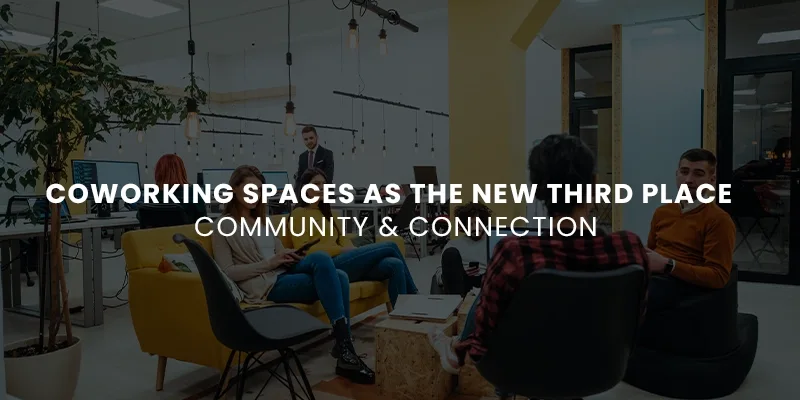Coworking Spaces as the New Third Place | Community & Connection
In the traditional rhythm of life, we’ve always had two main places: home and work. But sociologist Ray Oldenburg introduced a vital third: the “third place” — spaces where people gather, socialize, and build community. Think cafés, libraries, parks, or local pubs. Now, enter coworking spaces — and suddenly, these “third places” are evolving into something more powerful than ever before.
Coworking isn’t just about having a desk anymore. It’s becoming the new local café, gym buddy, brainstorm zone, and sometimes, even your therapist’s couch (minus the therapist). But what’s behind this shift? Let’s break it down.
First, What Is a “Third Place”?
According to Oldenburg, a third place is a social environment that is not your home (first place) or your office (second place). It's somewhere in-between — a neutral ground that encourages interaction, conversation, creativity, and belonging. Think about the coffee shop you keep going back to, where the barista knows your name and that you take your latte with oat milk.
Third places matter because they fulfill a basic psychological need: connection. They help reduce loneliness, increase mental wellness, and spark serendipitous relationships—things that rigid office cubicles and WFH setups often lack.
But Here’s the Problem: Traditional Third Places Are Shrinking
Walk into a café today and it’s filled with people wearing headphones, heads down in laptops. Libraries have stricter noise rules. Public parks? Great, but not exactly ideal for ideation sessions or Zoom calls. Our cities are losing spaces that naturally bring people together in meaningful ways.
That’s where coworking spaces step in as a modern third place — not replacing cafés, but remixing the formula.
Coworking Spaces: The New “Third Place” That Works
Coworking spaces are no longer just office alternatives; they are curated ecosystems designed for humans — not just workers. They blend the productivity of a workspace with the warmth of a community hangout.
Here’s how coworking spaces psychologically tick the boxes of a third place:
1. Neutral Ground with Low Barriers
You don’t need to be part of a corporate ladder to access them. Freelancers, remote employees, entrepreneurs — all sit shoulder to shoulder. Hierarchies flatten, and interactions feel more natural.
2. A Sense of Belonging
Unlike rigid offices or isolating home setups, coworking spaces offer gentle, ambient socialization. You might not talk to everyone every day, but that shared head-nod, that quick smile, or post-lunch chat makes you feel seen. That’s community.
3. Flexibility with Familiarity
Coworking spaces often offer flexible seating, but many still return to “their” corner, building routines and mini-rituals. It gives both autonomy and structure — a balance many remote workers crave.
4. Cross-Pollination of Ideas
The mix of industries and people creates an intellectually stimulating environment. A digital marketer can pick up a design tip from someone in UX. A solopreneur might meet a future co-founder. These aren’t just collisions — they’re intentional interactions built into the architecture of coworking.
Let’s Talk Psychology: Why This Works
- Humans are wired for connection. Even introverts need a sense of social proximity. Coworking offers “together-alone” energy: you're surrounded by people but not obliged to talk.
- Routine enhances mental health. Regular work hours in a structured, inspiring environment reduce decision fatigue and procrastination.
- Environmental triggers boost focus. Coworking spaces are often designed with sensory wellness in mind: natural light, ergonomic furniture, greenery, and quiet zones — all tailored to help your brain switch into work mode.
- Belonging combats burnout. Having a place where “everybody kind of knows your hustle” makes the grind feel less lonely.
From Transactional to Transformational
Initially, coworking was all about flexibility and cost-saving. But now, it’s morphing into something deeper: a place to belong, create, and grow. That’s why brands like WeWork, 91Springboard, Awfis, and local boutique hubs aren’t just selling desks — they’re building experiences.
From wellness events and yoga mornings to podcast rooms and networking mixers — coworking brands are tapping into the emotional needs of modern workers. It’s not just where you plug in; it’s where you plug into a vibe, a tribe, a purpose.
Coworking as Urban Infrastructure
If cities are to become more human-centric, coworking spaces play a critical role. They act as hybrid nodes — part community center, part innovation lab. In fact, urban planners are now considering coworking spaces as important infrastructure for:
- Reducing commutes and decentralizing work
- Revitalizing underutilized commercial buildings
- Encouraging hyperlocal business ecosystems
- Bridging the work-life-community gap
In India, especially post-pandemic, tier-1 and tier-2 cities are seeing a boom in such spaces, not just in CBDs but in neighborhoods where demand for walkable, accessible work-life hubs is skyrocketing.
So, What’s the Future of Coworking as a Third Place?
Coworking spaces are set to evolve beyond just startups and freelancers. We’re talking:
- Hybrid team outposts for global firms
- Niche coworking — for women, creatives, wellness pros
- Tech-integrated spaces with AI meeting assistants and smart energy systems
- Community-first spaces that feel like your second home
In short: coworking is no longer just a service. It’s becoming a movement.
Final Thoughts
If your work-from-home routine is starting to feel stale, or if your office cubicle is sapping your soul, a coworking space might be more than just a productivity upgrade. It could be your new third place — where ideas brew, people connect, and you rediscover the joy of working with others.
Because in the end, we’re not just looking for a desk. We’re looking for a place that feels right — where you’re not just working, you’re belonging.
